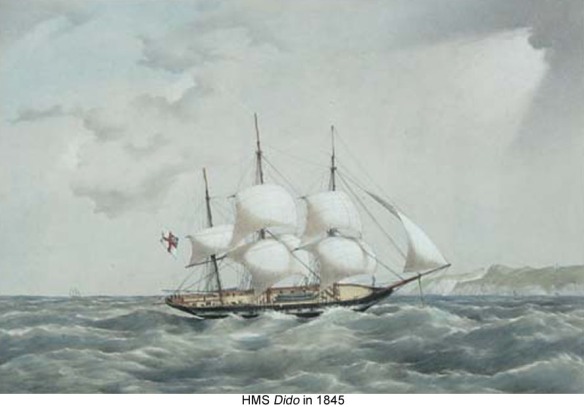HMS Dido was an 18-gun corvette launched in 1836, used as a coal hulk after 1860, and sold in 1903.
DYAK WAR PRAHU.
These light, swift vessels were extensively used off the coast of northern Borneo by pirates who relied on speed and a large crew that could board enemy ships.
As in the case of the Barbary pirates, the technologically advanced navies of the West were no longer prepared to tolerate predatory sea practices in the nineteenth century. In many regions, raids on merchant shipping had been a part of life for centuries, from the Mediterranean to Malaysia.
Pirate craft tended to be light vessels, relying on speed and a heavy crew of boarders to take enemy ships. These pirates knew better than to assault a Western naval vessel with its heavy armament and well-trained crew. So Western naval forces, especially those of Britain, had to hunt their enemies up rivers, along dangerous coasts and against the wind. Again, steamboats proved indispensable.
Piracy was endemic in the Malay Archipelago in the mid-nineteenth century. Much of the region’s trade was based on rivers, and there was no strong central government to police the coast. The British naval policy was to attack pirates whenever they were encountered. In the late 1820s, a squadron of the Royal Navy fought pirates on the coast of Perak – not only did this protect shipping but it also promoted British interests in the region and gained valuable fighting experience for British sailors. In 1831, and again in 1838, the British fought supposed pirates who attacked the sultanate of Kedah, in a situation that may have had more to do with the British quest for influence in the region than any real pirate threat. Certainly pirate fighting helped the British spread their influence far beyond their settlements at Penang, Singapore and Malacca.
Often such pirate-hunting ventures seem to have been almost accidental, as captains identified a need for intervention and pursued it. In Malaya, a large number of such expeditions were at the behest of one of the most interesting adventurers of the nineteenth century, James Brooke (1803- 1868), who was named raja of Sarawak in 1841. He waged war on pirates using his own native forces operating in Malay war prahus. But whenever possible, Brooke called on warships in the vicinity, particularly HMS Dido, which was stationed in the region from 1843 to 1849.
Sailing ships had considerable success against pirates, whether in the South China Sea or in the Persian Gulf, where the British intervened in the 1830s to stop the piracy of the Qasimi Arabs. But it was all too easy for pirate bands to take refuge up rivers or behind shallows where a conventional sloop or frigate could not approach. To finish the job, the Royal Navy gradually introduced steam-powered gunboats. Piracy on the South China coast was gradually ended by using gunboats to penetrate pirate lairs.
Even so, Western naval forces never completely stamped out raids on merchant shipping. Raja Brooke summed up the problem in March 1863, when a squadron of eight vessels were hunting pirates with little success off Sarawak: they were, he said, a herd of elephants looking for mosquitoes. The British did, however, enjoy enough success to give credit to the idea of a Pax Britannica, under which the Royal Navy kept peace on the seas.
